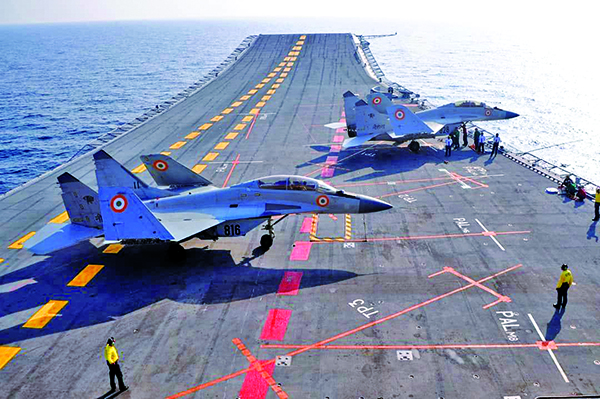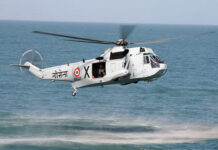The Indian Navy has been operating aircraft carriers since 1961. INS Vikrant is India’s first indigenously built aircraft carrier. With the induction of Vikrant and subsequent proving of its combat capability, it will join INS Vikramaditya as one of the most valuable assets of the Indian Navy.
With China aggressively building new aircraft carriers and a blue-water navy to counter the US and project power around the globe, the Indian Navy is now pushing hard for its long-standing case for a third and much bigger aircraft carrier to retain its combat edge in the Indian Ocean Region (IOR).
Naval chief, Admiral Hari Kumar, mentioned during his Navy Day 2022 press conference, ‘It’s not about either carrier or submarine, but the right balance between ships, submarines and aircraft.’ The third aircraft carrier, which the navy desires, is expected to be of 65,000 to 70,000 tonnes as compared to INS Vikrant of 45,000 tonnes. It is estimated to cost approximately Rs 80,000 to 90,000 crore, including provision of aircraft and helicopters.
Blue water capabilities only flow through aircraft carriers. In case India possesses three aircraft carriers, at any one time, two would be available. On the other hand, there is a counter view that the age of aircraft carriers has passed. Its cost of construction, maintenance and alternatives, including use of island territories as airbases, and submarines for sea denial are cheaper and more viable.
Aircraft carriers are known to have lengthy maintenance schedules. The cycle of maintenance can lead to an absence of a carrier for years, as has been the case with the refit of India’s lone aircraft carrier the 45,000-tonne INS Vikramaditya, acquired from Russia for $2.33 billion in November 2013. Its refit started in the beginning of 2021 and still continues. It has been delayed due to a fire onboard in July.
With one aircraft carrier still under maintenance and one yet to be inducted, the Indian Navy will be operating without one for some more time.
In Support of the Third Aircraft Carrier
The overall air power that an aircraft carrier brings to the operational area is not limited to the tremendous capabilities that the fighter aircraft can deliver. It also includes the capabilities of the carrier-borne helicopters and the weapon package of the escort and support ships that sail with the carrier as part of the Carrier Battle Group.
An aircraft carrier is central to the Navy’s concept of operations, and the Navy would need three aircraft carriers to safeguard national maritime interests within our areas of interest against the backdrop of changing geopolitics in the Indian Ocean region. The Carrier Battle Groups are undoubtedly the source of power projection, and provide freedom of manoeuvre in the vast area of operations of interests. The three carriers would arm the Navy with the required teeth to deter our potential adversaries from any misadventure, as well as to establish credible deterrence in our area of operations. The maritime capability perspective plan of the Indian Navy, therefore, envisages induction of three aircraft carriers to ensure development of capability to operate two Carrier Battle Groups at all times, and with the third carrier under maintenance.
The indigenous ecosystem has been created by building the IAC. The stage is now well set to take the next step forward to indigenously build the next aircraft carrier to ensure the expertise gained is utilized to the maximum in times to come.
After building the Rs 20,000-crore IAC, which took 13 years from keel-laying to delivery after being first sanctioned by the government way back in January 2003, the Cochin Shipyard (CSL) is ready for the next carrier project.
Once the go-ahead is given, CSL can build a warship similar to IAC in eight years. Its new 310-meter dry dock will be ready by 2024 to build a 65,000-tonne carrier.
Against Aircraft Carriers
Aircraft carriers are vulnerable to long-range missiles such as the Chinese DF 21D and DF 26. The loss of an aircraft carrier in operations is a major loss for the nation. India does not have an expeditionary doctrine or forces, hence, aircraft carriers are considered unnecessary. It is arguable whether the Indian Navy should have a third carrier or build additional submarines, whose strength has reduced to 16 from the desired 24.
Submarines can effectively provide a ‘sea denial strategy’ as against a ‘sea control strategy’ created by ‘Carrier Battle Groups (CBG).’ Sea denial may be a better option for the country, which lacks financial resources.
Due to shortfall in funds,the Navy has reduced its projections for a 200-warship navy by 2027 to 175. It has also lowered its demands for helicopters and P 81 Maritime multi-mission aircraft.
Air power experts root for air to air refuellers to enhance the range of fighter aircraft and support naval operations from shore-based airfields.
Aircraft carriers project a nation’s capabilities in peace time. However, Indian aircraft carriers are unlikely to be operationally employed beyond the Indian Ocean region, for which a two-carrier fleet is sufficient.
Operating three CBGs is also requires the necessary support flotilla, even if two are operational at any one time.
Threat from China
China already operates two carriers, Liaoning and Shandong, and is fast building two more with CATOBAR configuration. The third Chinese carrier, the over 80,000-tonne Fujian, was `launched’ in June. The US has 11 `super’ 100,000-tonne nuclear-powered carriers, each of which carries 80-90 fighters and aircraft.
China started manufacturing its first aircraft carrier in 2012 and commissioned its third indigenous one, Fujian, in June this year.
China has become the biggest Navy with 355 warships and submarines while India’s total fleet strength is 130.
In its quest for regional and global power, China made a decisive turn to the sea around 20 years back, and the balance between maritime and continental orientation began to shift towards the former. This was stepped up since 2013, under President Xi Jinping. In the last 15 years or so, the PLA Navy has added over 100 major ships and submarines to its fleet. It is the most rapid growth by any Navy for a long time in recent history. PLA Navy deployments have also grown rapidly, and new bases and access arrangements in the Indo-Pacific have been operationalised.
These increases imply hardening of the Chinese posture and continuation of aggressive approaches, unless efforts by many other countries towards a “push back” yield some results. It will also mean increased deployments and presence of the PLA Navy in other areas, including the Indian Ocean. The challenge can manifest in a variety of ways, on trade routes, shipping, coercive approaches in India’s neighbourhood, and other conventional military threats. The rapid growth of the PLA Navy is also meant to create maritime power asymmetries, which would need suitable responses.
The security challenges posed by the widening footprint of the PLA Navy, the potential of China-Pakistan collusion, and growing traditional and non-traditional threats at sea are pointers towards a further increase in the Indian Navy’s roles and responsibilities.
Comments
For the Indian Navy’s roles and responsibilities, both sea control or sea denial are needed. The Navy must be a balanced force, with the right mix of assets and capabilities that can address the threats and challenges.
The third indigenous aircraft carrier is needed and fits well with the role that India should play in the region, as well as for our security requirements. Integral air power has many strategic, operational and tactical advantages that cannot be replicated by shore-based air power. These include strengthening strategic stability in India’s areas of interest, displaying resolve and intent where required, deterrence, sea-control, trade and SLOC security, full integration of the air wing with the situation at sea, control and direction of aircraft for air combat and time critical targets, response time, persistence, and inherent flexibility.
Vulnerabilities of carriers should be addressed through tactical planning, self and collective defence capabilities, and countermeasures.
The broad contours of the ship, including size, tonnage, configuration, propulsion, and the air wing have been debated for long. The proposed indigenous aircraft carrier-2 (IAC-2, expected to be 65-70,000 tonnes) will supplement INS Vikramaditya (46,000 tonnes), and INS Vikrant, the 44,500-tonne IAC-1.
It is time to take a decision.


















